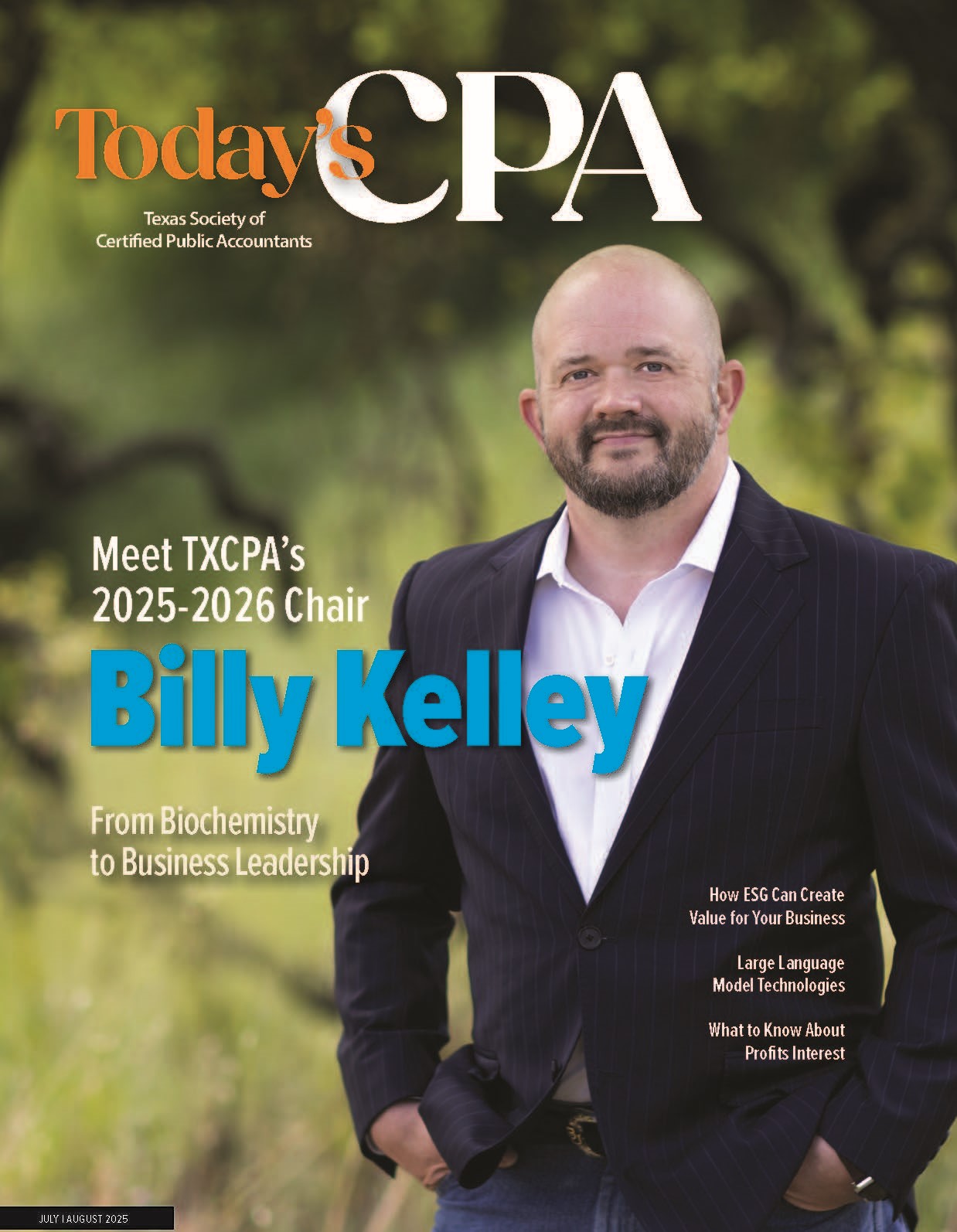July 03, 2025
CPE: What to Know About Profits Interest
By Barbara W. Scofield, Ph.D., CPA, and Jim Martin, MPA, CPA
~~ ~~ ~~ ~~ ~~ ~~ ~~ ~~ ~~ ~~ ~~ ~~ ~~ ~~ ~~ ~~ ~~ ~~ ~~ ~~
CPE Self Study Article & Quiz Register to gain access to the self-study quiz and earn one hour of continuing professional education credit by passing the quiz.
~~ ~~ ~~ ~~ ~~ ~~ ~~ ~~ ~~ ~~ ~~ ~~ ~~ ~~ ~~ ~~ ~~ ~~ ~~ ~~
CPE Hours: 1
Curriculum: Accounting and Auditing; Tax
Level: Basic
Designed For: CPAs in industry and public practice; tax practitioners
Objectives: Review IRS regulations and FASB standards to provide companies and employees with the guidance needed to structure profits-interest contracts that align with their desired tax and financial reporting outcomes
Key Topics: Definition and use of profits interest; tax treatment; FASB financial reporting guidance; implementation guidance for companies; and strategic considerations
Prerequisites: None
Advanced Preparation: None
~~ ~~ ~~ ~~ ~~ ~~ ~~ ~~ ~~ ~~ ~~ ~~ ~~ ~~ ~~ ~~ ~~ ~~ ~~ ~~
Profits interest is an ownership interest, usually in a partnership, that provides returns based on future profits and losses of an entity with no capital interest. When used as a part of a compensation system, a profits interest eliminates the need for incoming profits-interest partners to contribute toward capital, since they have no claims to already earned or acquired capital.
In addition, profits-interest contracts offer tax advantages. If criteria on initial value and the length of time of the contract are followed, profits-interest distributions are considered capital gains rather than ordinary income, lowering tax on distributions. For these reasons, profits-interest partnership participation is common, especially in real estate, investment, entertainment, and natural resource industries. Entities as diverse as the Houston Astros1 baseball team and WeWork2 use profits-interest contracts for executives.
This article will look at both the Internal Revenue Service (IRS) regulations and the Financial Accounting Standards Board (FASB) standards to provide companies and employees with the information they need to create the profits-interest contracts that fit with the tax outcome and financial reporting outcome desired.
Tax Regulations and Profits Interest
The tax treatment of a profits interest to the recipient of the interest and to the grantor of the interest traveled an uncertain path for years as courts in different jurisdictions reached conflicting conclusions. Does the granting of a profits interest to a partner or prospective partner result in taxable income to the recipient as ordinary income under IRC Section 83 in the year granted? In some jurisdictions, courts held no income tax was due in the year the profit interest is granted.
In other jurisdictions, where the courts held that the granting of the interest resulted in ordinary income to the recipient at the grant date, the presumptive tax treatment to the granting partnership would be a deduction in the year of grant, counting it as income from compensation for the recipient and a deductible expense for the grantee. However, immediate recognition of the value of profits interest as ordinary income with a corresponding deduction was a far cry from the intended result. That is, the tax planner’s goal was usually to defer the taxability of the profit interest to the partner until the partner’s interest substantially vests or is sold or redeemed, years in the future. At that time, the hope was also for the partner to receive long-term capital gain treatment. Such a long-term capital gain would be taxed at a federal income tax rate of 0% to 20% versus up to 39.6% for ordinary income, depending on the taxable year involved.
After years of uncertainty, the IRS brought more clarity to the tax treatment of the receipt of a profits interest with the issuance of Rev. Proc. 93-27 and Rev. Proc 2001-43. These two provisions provided a “safe harbor” whereby the IRS would not consider a profits interest to be a capital interest when granted and would not consider the receipt of the interest to be taxable to the recipient when granted. In essence, the recipient was deemed to have received a $0 liquidation value asset as its profits interest on the day of receipt. The Revenue Procedures also enabled compliant taxpayers, who own a profits interest, to receive capital gains treatment when the interest vests or is disposed of in the future.
Three specific situations were identified as not receiving the desired favorable tax treatment of a $0 liquidation value profits interest. Rev. Proc. 93-27 provides that it does not apply to a profits interest:
- If the profits interest relates to a substantially certain and predictable stream of income from partnership assets, such as income from high-quality debt securities or a high-quality net lease;
- If within two years of receipt, the partner disposes of the profits interest; or
- If the profits interest is a limited partnership interest in a "publicly traded partnership" within the meaning of section 7704(b) of the Internal Revenue Code.
Secondly, Rev. Proc 2001-43 further clarifies the favorable tax treatment by setting the date the partner becomes the owner of the untaxed $0 basis profits interest at the grant date subject to the two conditions below. By avoiding the three disqualifying events of Rev. Proc. 93-27 described above, Rev. Proc 2001-43 describes the clear path of a partner to receive a profits interest that will not be taxed at the now established grant date as opposed to a taxable capital interest that would have been subject to tax at grant date. Rev. Proc 2001-43 provides:
- The partnership and the service provider (partner or future partner) treat the service provider as the owner of the partnership interest from the date of its grant and the service provider takes into account the distributive share of partnership income, gain, loss, deduction, and credit associated with that interest in computing the service provider’s income tax liability for the entire period during which the service provider has the interest.
- Upon the grant of the interest or at the time that the interest becomes substantially vested, neither the partnership nor any of the partners deducts any amount (as wages, compensation or otherwise) for the fair market value of the interest.
Finally, one last election available to taxpayers in receipt of a profit interest, that further locks in the $0 basis and date of receipt, is the Section 83(b) election. This election, if made within 30 days of the grant date, sets the acquisition date of the profits interest and presumptive $0 basis for use in the determination of a future long-term capital gain upon disposal of the profits interest.
In summary, favorable tax treatment requires partnership avoidance of the three disqualifying behaviors outlined in Rev. Proc. 93-27 and adhering to the two requirements of Rev. Proc 2001-43.
Financial Reporting and Profits Interest
The financial reporting classification recognizes the limited rights provided to profits interest holders. These contracts can have many different features determining vesting and payouts. The key feature that determines the rights conveyed by profits-interest contracts is eligibility to participate in payouts associated with exit events of the underlying entity.
Exit events are events such as an initial public offering, a change in control or a liquidation of the entity’s assets that bring the profits-interest contract to a conclusion. Profits-interest contracts in which the recipients receive proceeds at the time of an exit event are a hallmark of having a residual interest in a company and thus being characterized as stock-based compensation at the date of grant. On the other hand, a profits-interest contract that terminates without any further proceeds at the time of an exit event is characteristic of compensation that does not share in the overall risk of the company and is not considered stock-based compensation.
FASB has provided clarification on the financial reporting for profits-interest awards by issuing ASC 2024-01. The Private Company Council reported to FASB that there were differences in the accounting treatment of the issuance of profits-interest contracts in practice even when the contracts had matching features. The differences stemmed from interpreting FASB guidance on the underlying classification issue. Is the contract stock-based compensation that should be accounted for using ASC Topic 718 – Stock Compensation, or is it general compensation that should be accounted for using ASC Topic 710 Compensation – General? The Codification already set the guiding principle in 20043 with SFAS 123 R, which is now incorporated into ASC 718-10-15-3:
The guidance in the Compensation – Stock Compensation Topic applies to all share-based payment transactions in which a grantor acquires goods or services to be used or consumed in the grantor's own operations . . . issuing (or offering to issue) its shares, share options or other equity instruments.
When is profits interest an “other equity instrument?” FASB now provides four illustrations to help issuers apply this general rule consistently. Companies providing a profits interest that qualifies as share-based compensation must estimate its fair value at the date of grant, allocate the compensation expense over the vesting period and include the value in Stockholders’ Equity. Companies providing it as general compensation can avoid balance sheet involvement in their financial reporting.
ASU 2024-01 Compensation – Stock Compensation (Topic 718): Scope Application of Profits Interest and Similar Awards issued in March 2024 illustrates how current GAAP applies to a variety of profits-interest contracts. (See Table 1 below.) The illustrations present a typical profits interest context with different vesting conditions, distribution policies, treatment when an employee terminates employment, and outcome at the time of an exit event. Profits interest will be a share-based compensation that follows Topic 718 when the returns to the recipient are based, at least in part, on the share price, market value or fair value of the company.
Case A: ASC 718-10-55-140 to 141 | Case B: ASC 718-10-55-142 to 144 | Case C: ASC 718-10-55-145 to 146 | Case D: ASC 718-10-55-147 to 148 | |
Is it share-based compensation? | Yes. | Yes. | Yes. | No. |
Vesting | Three-year service period. Cliff vesting. Immediate vesting at an exit event. | Immediate vesting at an exit event only. | No vesting. | Three-year service period. Cliff vesting. Immediate vesting at an exit event. |
Distributions | Participation in distributions subordinate to other equity after vesting. | Participation in distributions subordinate to other equity beginning at date of grant. | No distributions. | Distribution after three years of service at a fixed percentage of prior year income. |
At termination of employee | If vested, issuer has a right to repurchase at fair value. | Recipient forfeits interest at termination. | Recipient forfeits interest at termination. | Recipient forfeits interest at termination. |
At an exit event | Recipient may retain or, if settling, will use subordinated distribution as above. | Recipient may retain or settle based on exit event. | Recipient receives cash based on fair value of other equity. | No distributions at exit events. |
Illustrations A to C portray profits-interest compensation classified as share-based with the following profits-interest features.
Treatment of Distributions
- Distributions that begin at date of grant (Case B) or at vesting (Case A)
- Distributions in a waterfall after class A equity (Case A and B) or no distributions at all (Case C)
Vesting Policy
- Vesting over a service period (Case A and B)
- Vesting at an exit event (Case A, B and C
Alternative policy at the termination of employees
- Retention of profits interest (Case A)
- Call option for issuer repurchase (Case A)
- Forfeiture (Case B and C) at termination
Exit Event
- Retention of profits interest (Case A and B)
- Settlement based on fair value of other equity (Case C)
- Settlement based on the exit event contract (Case B)
- Settlement subordinated to other equity (Case A)
These illustrations demonstrate that the key risk-sharing feature that determines share-based compensation treatment focuses on variable returns at the time of an exit event.
Case D illustrates profits-interest compensation that is classified as general compensation and not share-based compensation. In this case, distributions are based on a fixed percentage of the prior year’s income and no distributions occur at an exit event or employee’s termination. This illustration has distributions based on an operating measure and not on an equity-based measure, and no equity instrument will be issued, even at an exit event.
In summary, financial reporting distinguishes the risk of sharing company GAAP income performance and the risk of sharing the market value of the company. Profits-interest contracts must be evaluated to distinguish which type of risk sharing occurs.
Applying Profits Interest Requirements
Companies with profits-interest contracts now have specific standards from FASB as well as regulations from the IRS to use in planning the specific financial statement and tax results desired. It is important to realize that there are profits-interest contracts that provide favorable tax treatment to employees that may be classified as either share-based compensation or general compensation. Likewise, there are profits-interest contracts that are classified as share-based compensation but may have favorable or unfavorable tax treatment.
What should a company that offers profits-interest partnerships do now that ASC 2024-01 has been issued? The transition requirements allow either prospective or retrospective adoption of this new GAAP. Companies will need to review their currently open profits-interest contracts and identify any re-classification based on the new illustrations. If there is sufficient information readily available to restate past compensation practices, companies may want to adjust past financial statements for any misclassifications and put all contracts on a consistent basis. However, ASC 2024-01 allows prospective treatment so that the company can recognize share-based profits-interest equity beginning in the year of adoption.
In addition, companies now have an opportunity to review any planned profits-interest partnership contracts to ensure that the financial accounting treatment intended matches with the GAAP classification guidance. If exit-event equity risk sharing is crucial to the profits-interest contract’s intent, the profits interest will be share-based compensation and will share GAAP accounting with stock options and restricted stock compensation systems. If exit-event equity risk sharing can be eliminated from profits-interest contracts while still appropriately compensating profits-interest partners, companies can revise contracts to qualify for general compensation accounting treatment.
Strategic Business Tool with Tax Policy Uncertainty
Profits-interest contracts are both a common business strategy and controversial tax policy. While employees benefit from well-planned profits-interest contracts, employers must balance the greater financial reporting complexity that profits-interest contracts may require. (See Table 2.) However, as long as employees benefit from profit-sharing with their employers, these contracts will continue to be issued.
Employer Impact | Employee Impact | |
Corporate Strategy | Companies offer variable compensation that matches company performance, managing labor costs. Companies motivate employees for long-term commitment to the company. | Employee shares in the overall performance of the company. Employee shares future risk and reward, especially in start-up companies without large investment. |
Financial Reporting | When classified as share-based compensation, profits interest requires more complex estimates and annual accounting. | |
Tax | Distributions through profits interest can have a greater after-tax benefit to employees, so lower cash outflows have the same impact as higher-taxed compensation. | A well-designed plan results in distributions classified as capital gains, taxed at a lower tax rate than regular income. |
With ASC 2024-01, FASB brought consistency to profits interest financial reporting – but stability in tax treatment is less clear. Ending the capital gains treatment of profits interest continues to be on the radar of federal budget proposals.
 About the Authors:
About the Authors:
Barbara W. Scofield, Ph.D., CPA, is Professor of Accounting at Washburn University in Topeka, Kansas. Contact her at barbara.scofield@washburn.edu.
Jim Martin, MPA, CPA, is Henrietta and G.W. Snyder Jr. Professor in Business and Senior Lecturer at Washburn University in Topeka, Kansas.
 Footnotes:
Footnotes:
1. “General Manager During Sign-Stealing Scandal Sues Astros” by Tyler Kepner. New York Times. November 10, 2020.
2. “WeWork Sweetens Ex-Chief’s Exit Deal” by Eliot Brown and Maureen Farrell. Wall Street Journal. May 28, 2021.
3. SFAS 123R was issued in December 2004 and its text was incorporated into the Codification when the Codification was launched in 2009. Moreover, the 1995 SFAS 123’s original scope definition is largely consistent with that of SFAS 123R and ASC 718-10-15-3 in the Codification.
Thanks to the Sponsors of Today's CPA Magazine
This content was made possible by the sponsors of this issue of Today's CPA Magazine:
















